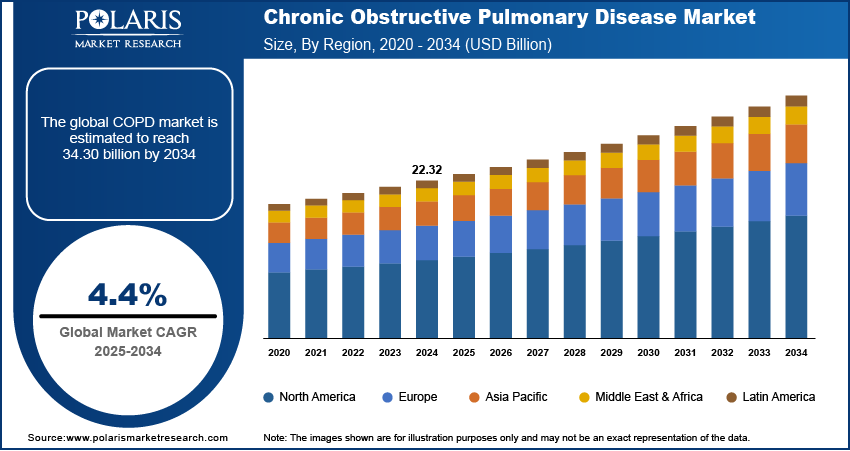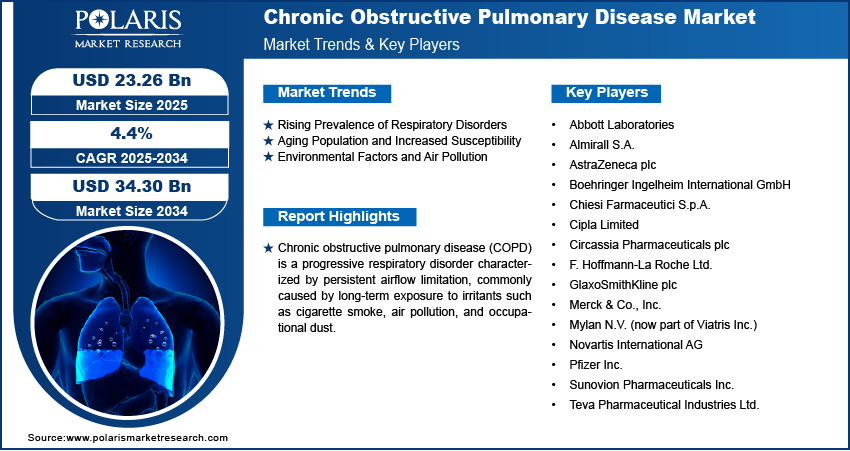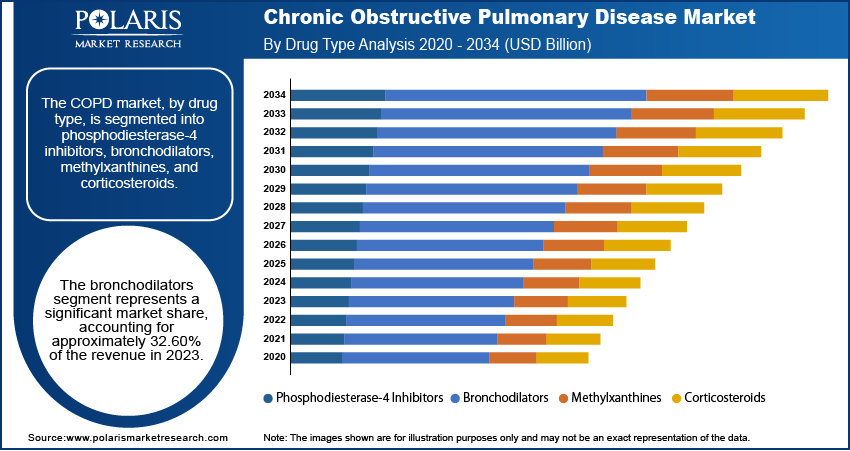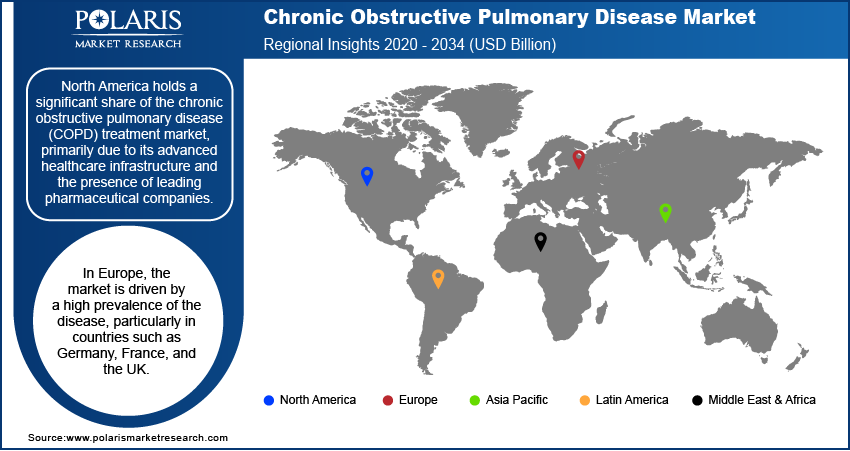
Chronic Obstructive Pulmonary Disease Market Size, Share, Trends, Industry Analysis Report
: By Drug Type (Phosphodiesterase-4 Inhibitors, Bronchodilators, Methylxanthines, and Corticosteroids), Product Type, End Users, and Region (North America, Europe, Asia Pacific, Latin America, and Middle East & Africa) – Market Forecast, 2025–2034
- Published Date:Apr-2025
- Pages: 118
- Format: PDF
- Report ID: PM1324
- Base Year: 2024
- Historical Data: 2020-2023
Chronic Obstructive Pulmonary Disease Market Overview
The chronic obstructive pulmonary disease (COPD) market size was valued at USD 22.32 billion in 2024. The market is projected to grow from USD 23.26 billion in 2025 to USD 34.30 billion by 2034, exhibiting a CAGR of 4.4% during 2025–2034.
The chronic obstructive pulmonary disease market encompasses the diagnosis, treatment, and management of COPD, a progressive respiratory disease characterized by airflow obstruction and breathing difficulties. It includes pharmaceuticals (bronchodilators, corticosteroids, combination therapies), medical devices (inhalers, nebulizers, oxygen therapy, non-invasive ventilation), and emerging biologics and gene therapies.
The chronic obstructive pulmonary disease market growth is driven by the increasing prevalence of respiratory disorders, rising geriatric population, and growing exposure to risk factors such as smoking and air pollution. Advancements in drug development, including novel inhalation therapies and biologics, are also contributing to market growth. Key trends include the adoption of digital health solutions for remote monitoring and the expansion of personalized treatment approaches. Additionally, government initiatives and healthcare investments aimed at improving respiratory disease management are further influencing the COPD market expansion. The market is also witnessing increased research and development efforts to introduce effective and long-acting therapeutics.

To Understand More About this Research: Request a Free Sample Report
Chronic Obstructive Pulmonary Disease Market Dynamics
Rising Prevalence of Respiratory Disorders
The increasing prevalence of respiratory disorders, particularly chronic obstructive pulmonary disease (COPD), is a significant driver of the COPD market demand. According to the World Health Organization (WHO), COPD is the third leading cause of death worldwide, causing 3.23 million deaths in 2019. The same report indicates that nearly 90% of COPD deaths in those under 70 years of age occur in low- and middle-income countries. This escalating burden underscores the need for effective treatments and management strategies, thereby propelling the market growth.
Aging Population and Increased Susceptibility
The global rise in the aging population contributes to the COPD market growth. Older adults are more susceptible to developing COPD due to age-related physiological changes and prolonged exposure to risk factors. The United Nations reports that the number of persons aged 65 years and above is projected to double from 727 million in 2020 to 1.5 billion in 2050. This demographic shift is expected to lead to a higher incidence of COPD, thereby increasing the demand for therapeutic interventions.
Environmental Factors and Air Pollution
Environmental factors, particularly air pollution, play a crucial role in the rising incidence of COPD. The WHO identifies exposure to indoor and outdoor air pollutants as significant risk factors for developing COPD. In low- and middle-income countries, household air pollution from the use of biomass fuels for cooking and heating is a major contributor. Efforts to mitigate air pollution and reduce exposure are essential components in managing and preventing COPD, influencing chronic obstructive pulmonary disease market trends.

Chronic Obstructive Pulmonary Disease (COPD) Market Segment Insights
Chronic Obstructive Pulmonary Disease Market Assessment – Drug Type-Based Insights
The COPD market, by drug type, is segmented into phosphodiesterase-4 inhibitors, bronchodilators, methylxanthines, and corticosteroids. In 2024, the bronchodilators segment accounted for the significant market share. These medications function by relaxing the muscles around the airways, thereby improving airflow and alleviating symptoms such as shortness of breath and wheezing. The widespread prevalence of COPD symptoms necessitating immediate relief has established bronchodilators as a primary therapeutic option. Both short-acting and long-acting bronchodilators are prescribed based on symptom severity and frequency of exacerbations. The inhalation route of administration is particularly favored, as it allows for rapid onset of action and direct delivery to the lungs, enhancing therapeutic efficacy.
The corticosteroids segment accounted for a significant share of the chronic obstructive pulmonary disease (COPD) market due to its widespread use in reducing airway inflammation and managing exacerbations. Inhaled corticosteroids (ICS), often combined with long-acting bronchodilators, are essential in controlling moderate to severe COPD cases, particularly in patients with frequent flare-ups. These drugs help decrease mucus production, prevent airway constriction, and improve lung function. The increasing prevalence of COPD, growing adoption of combination therapies, and physician preference for corticosteroids in managing chronic inflammation have further contributed to the segment's dominance. Additionally, advancements in inhalation technology have enhanced drug delivery efficiency.
Chronic Obstructive Pulmonary Disease Market Outlook– Product Type-Based Insights
The COPD market, by product type, is segmented into inhalers and nebulizers. The inhalers segment dominates the COPD market share. This dominance is attributed to their portability, ease of use, and rapid drug delivery capabilities, making them a preferred choice among patients and healthcare providers. Inhalers, including dry powder inhalers (DPIs), metered dose inhalers (MDIs), and soft mist inhalers (SMIs), offer effective management of COPD symptoms by delivering medication directly to the lungs, thereby enhancing therapeutic outcomes. The increasing prevalence of COPD and the rising demand for maintenance and rescue therapies contribute to the sustained growth of the inhalers segment.
Nebulizers also play a crucial role in COPD management, particularly for patients who may have difficulty using inhalers due to severe symptoms or physical limitations. These devices convert liquid medication into a fine mist, facilitating easier inhalation and ensuring effective drug delivery to the respiratory tract. Advancements in nebulizer technology, such as the development of portable and mesh nebulizers, have improved patient compliance and expanded their application in home healthcare settings. The growing emphasis on personalized treatment approaches and the need for effective management of acute exacerbations are driving the adoption of nebulizers in the COPD treatment landscape.
Chronic Obstructive Pulmonary Disease Market Evaluation – End Users-Based Insights
The COPD market, by end users, is segmented into hospitals & clinics, homecare settings, and others. The hospitals and clinics segment represents a significant market share, accounting for a substantial portion of service delivery. This prominence is attributed to the availability of specialized medical personnel, advanced diagnostic tools, and comprehensive treatment options within these facilities. Patients often prefer hospitals and clinics for managing COPD due to the accessibility of emergency care and the assurance of receiving evidence-based interventions. The structured environment of these institutions supports the implementation of standardized care protocols, contributing to improved patient outcomes.
The homecare settings segment is experiencing notable growth, driven by the increasing emphasis on patient-centered care, advancements in portable medical technologies, and the rising demand for cost-effective healthcare solutions. Homecare allows patients to receive treatment in a familiar environment, which can enhance comfort and adherence to therapy. Services such as home-based oxygen therapy, respiratory therapy, and telemedicine consultations are becoming more prevalent, reflecting a shift toward decentralized care models. The growing recognition of the benefits associated with homecare is contributing to its expanding role in COPD management.

Chronic Obstructive Pulmonary Disease Market Regional Insights
By region, the chronic obstructive pulmonary disease market is segmented into North America, Europe, Asia Pacific, Middle East & Africa, and Latin America. North America holds a significant share of the chronic obstructive pulmonary disease (COPD) market revenue, primarily due to its advanced healthcare infrastructure and the presence of leading pharmaceutical companies. The region's high prevalence of COPD, driven by factors such as smoking and environmental pollutants, contributes to the substantial demand for effective treatments. Additionally, favorable reimbursement policies and extensive research and development activities support the availability and adoption of innovative therapies. These elements collectively reinforce North America's prominent role in the global COPD treatment landscape.
In Europe, the chronic obstructive pulmonary disease (COPD) market expansion is driven by a high prevalence of the disease, particularly in countries such as Germany, France, and the UK. Factors contributing to this include an aging population and historical smoking rates. The region benefits from a favorable regulatory environment, with agencies such as the European Medicines Agency (EMA) facilitating the approval of advanced therapies. Additionally, there is a growing awareness of COPD, leading to increased diagnosis and treatment rates. Technological advancements and the adoption of combination therapies further support market growth in Europe.
The Asia Pacific COPD market is expanding due to rising disease prevalence, driven by factors such as increasing smoking rates, urbanization, and exposure to environmental pollutants. Countries such as China, India, and Japan are significant contributors to this growth. Improving healthcare infrastructure and greater awareness of COPD have led to higher diagnosis and treatment rates. The anticipated approval and launch of novel therapies, including targeted biologics and triple combination treatments, are expected to drive market expansion in this region.

Chronic Obstructive Pulmonary Disease Market – Key Players and Competitive Insights:
In the chronic obstructive pulmonary disease (COPD) market, several key players are actively contributing to advancements in treatment options. AstraZeneca plc is recognized for its development of combination inhalers that aid in managing COPD symptoms. GlaxoSmithKline plc has a significant presence with its range of respiratory therapies tailored for COPD patients. Boehringer Ingelheim International GmbH offers inhalation therapies designed to improve lung function in individuals with COPD. Novartis International AG provides treatments aimed at reducing exacerbations and enhancing patient quality of life. Teva Pharmaceutical Industries Ltd. is involved in producing generic and specialty medications for COPD management. Mylan N.V., now part of Viatris Inc., continues to supply accessible treatment options for COPD patients. Merck & Co., Inc. engages in the development of therapies targeting respiratory conditions, including COPD. Sunovion Pharmaceuticals Inc. focuses on inhalation therapies to address COPD symptoms. Chiesi Farmaceutici S.p.A. specializes in respiratory care, offering treatments for COPD.
Circassia Pharmaceuticals plc is involved in developing inhaled therapies for respiratory diseases, including COPD. Almirall S.A. contributes to the COPD market with its respiratory products. Pfizer Inc. engages in research and development of treatments for respiratory conditions, including COPD. Abbott Laboratories provides medical devices and diagnostics relevant to COPD management. F. Hoffmann-La Roche Ltd. is involved in developing therapies for various diseases, including respiratory conditions such as COPD. Cipla Limited offers a range of inhalation products for COPD treatment.
These companies are actively involved in research and development to introduce innovative therapies and improve existing treatment modalities for COPD. Their efforts encompass the development of novel inhalation devices, combination therapies, and biologics aimed at enhancing patient outcomes. The competitive landscape is characterized by a focus on patient-centric solutions, with companies striving to address unmet medical needs in COPD management. Collaborations, acquisitions, and strategic partnerships are common strategies employed to expand product portfolios and global reach. The commitment of these organizations to advancing COPD treatment contributes significantly to the evolving therapeutic landscape, offering hope for improved quality of life for patients worldwide.
AstraZeneca plc is a global biopharmaceutical company headquartered in Cambridge, United Kingdom. The company focuses on the discovery, development, and commercialization of prescription medicines, particularly in the areas of oncology, cardiovascular, renal, metabolism, and respiratory diseases. In the context of chronic obstructive pulmonary disease (COPD), AstraZeneca has developed treatments such as Breztri Aerosphere, a combination inhaler designed to manage COPD symptoms and reduce exacerbations.
GlaxoSmithKline plc (GSK), based in Brentford, United Kingdom, is another major player in the COPD market. GSK is dedicated to improving the quality of human life by enabling people to do more, feel better, and live longer. The company offers a range of inhaled respiratory medicines, including Advair Diskus and Trelegy Ellipta, which are used in the management of COPD.
List of Key Companies in Chronic Obstructive Pulmonary Disease Market
- Abbott Laboratories
- Almirall S.A.
- AstraZeneca plc
- Boehringer Ingelheim International GmbH
- Chiesi Farmaceutici S.p.A.
- Cipla Limited
- Circassia Pharmaceuticals plc
- F. Hoffmann-La Roche Ltd.
- GlaxoSmithKline plc
- Merck & Co., Inc.
- Mylan N.V. (now part of Viatris Inc.)
- Novartis International AG
- Pfizer Inc.
- Sunovion Pharmaceuticals Inc.
- Teva Pharmaceutical Industries Ltd.
Chronic Obstructive Pulmonary Disease Industry Developments
- September 2024: GSK reported that its asthma drug Nucala (mepolizumab) met the main goal in a late-stage study for treating COPD patients. Patients treated with Nucala and an inhaled maintenance therapy for up to 104 weeks experienced a lower annualized rate of moderate or severe exacerbations compared to those given a placebo.
- September 2024: The FDA approved Sanofi's Dupixent (dupilumab) as an add-on maintenance treatment for adults with inadequately controlled COPD and an eosinophilic phenotype. It is the first biologic medicine approved in the US for these patients.
- June 2024: Verona Pharma plc received approval from the U.S. Food and Drug Administration (FDA) for Ohtuvayre (ensifentrine), which is indicated for the maintenance therapy of chronic obstructive pulmonary disease (COPD) in adult patients.
Chronic Obstructive Pulmonary Disease Market Segmentation
By Drug Type Outlook (Revenue – USD Billion, 2020–2034)
- Phosphodiesterase-4 Inhibitors
- Bronchodilators
- Methylxanthines
- Corticosteroids
By Product Type Outlook (Revenue – USD Billion, 2020–2034)
- Inhalers
- Nebulizers
By End Users Outlook (Revenue – USD Billion, 2020–2034)
- Hospitals & Clinics
- Homecare Settings
- Others
By Regional Outlook (Revenue – USD Billion, 2020–2034)
- North America
- US
- Canada
- Europe
- Germany
- France
- UK
- Italy
- Spain
- Netherlands
- Russia
- Rest of Europe
- Asia Pacific
- China
- Japan
- India
- Malaysia
- South Korea
- Indonesia
- Australia
- Vietnam
- Rest of Asia Pacific
- Middle East & Africa
- Saudi Arabia
- UAE
- Israel
- South Africa
- Rest of Middle East & Africa
- Latin America
- Mexico
- Brazil
- Argentina
- Rest of Latin America
Chronic Obstructive Pulmonary Disease Market Report Scope
|
Report Attributes |
Details |
|
Market Size Value in 2024 |
USD 22.32 billion |
|
Market Size Value in 2025 |
USD 23.26 billion |
|
Revenue Forecast by 2034 |
USD 34.30 billion |
|
CAGR |
4.4% from 2025 to 2034 |
|
Base Year |
2024 |
|
Historical Data |
2020–2023 |
|
Forecast Period |
2025–2034 |
|
Quantitative Units |
Revenue in USD billion and CAGR from 2025 to 2034 |
|
Report Coverage |
Revenue Forecast, Market Competitive Landscape, Growth Factors, and Trends |
|
Segments Covered |
|
|
Regional Scope |
|
|
Competitive Landscape |
|
|
Report Format |
|
|
Customization |
Report customization as per your requirements with respect to countries, regions, and segmentation. |
How is the report valuable for an organization?
Workflow/Innovation Strategy
The chronic obstructive pulmonary disease market has been segmented into detailed segments of drug type, product type, and end users. Moreover, the study provides the reader with a detailed understanding of the different segments at both the global and regional levels.
Growth/Marketing Strategy
Companies in the COPD market focus on expanding their product portfolios through research and development of novel therapies, including combination inhalers and biologics. Strategic collaborations, and mergers and acquisitions help enhance market presence and strengthen distribution networks. Direct-to-consumer marketing, patient awareness programs, and physician engagement initiatives are commonly employed to drive product adoption. Companies also invest in expanding access through favorable pricing strategies, reimbursement support, and geographic expansion in emerging markets. Digital health solutions, such as remote patient monitoring and AI-driven diagnostics, are increasingly integrated to improve COPD management and treatment adherence.
FAQ's
The market size was valued at USD 22.32 billion in 2024 and is projected to grow to USD 34.30 billion by 2034.
The market is projected to register a CAGR of 4.4% during 2025–2034.
North America held the largest share of the market in 2024.
Several key players are actively contributing to advancements in treatment options. AstraZeneca plc is recognized for its development of combination inhalers that aid in managing COPD symptoms. GlaxoSmithKline plc has a significant presence with its range of respiratory therapies tailored for COPD patients. Boehringer Ingelheim International GmbH offers inhalation therapies designed to improve lung function in individuals suffering from COPD.
The bronchodilators segment accounted for the largest share of the market in 2024.
The inhalers segment accounted for a larger share of the market in 2024.
Chronic obstructive pulmonary disease (COPD) is a progressive respiratory condition characterized by persistent airflow limitation, making breathing difficult. It includes diseases such as chronic bronchitis and emphysema, primarily caused by long-term exposure to irritants such as cigarette smoke, air pollution, and occupational dust. Symptoms include shortness of breath, chronic cough, and excessive mucus production, which worsen over time. COPD is a major global health concern and a leading cause of morbidity and mortality. While there is no cure, treatments such as bronchodilators, corticosteroids, and pulmonary rehabilitation can help manage symptoms and improve quality of life.
A few key trends in the market are described below: Increased Adoption of Combination Therapies – Rising preference for fixed-dose combination inhalers to improve treatment efficacy and patient compliance. Advancements in Biologic Therapies – Growing development of biologics targeting inflammatory pathways to address severe COPD cases. Rising Use of Digital Health Solutions – Integration of remote monitoring, AI-driven diagnostics, and mobile applications to enhance disease management. Expansion in Emerging Markets – Increasing focus on developing nations due to rising COPD prevalence and improving healthcare access
A new company entering the chronic market must focus on developing innovative biologic therapies targeting inflammation and disease progression, as these treatments are gaining traction. Investing in digital health solutions, such as AI-driven diagnostics and remote patient monitoring, can enhance disease management and differentiate offerings. Expanding access to cost-effective generic inhalers in emerging markets presents a significant growth opportunity. Collaborating with healthcare providers for personalized treatment approaches and leveraging real-world data for better patient outcomes can also provide a competitive edge. Additionally, engaging in strategic partnerships for research, development, and distribution can accelerate market entry and expansion.
Companies manufacturing, distributing, or purchasing COPD treatment and diagnosis-related products and other consulting firms must buy the report.
